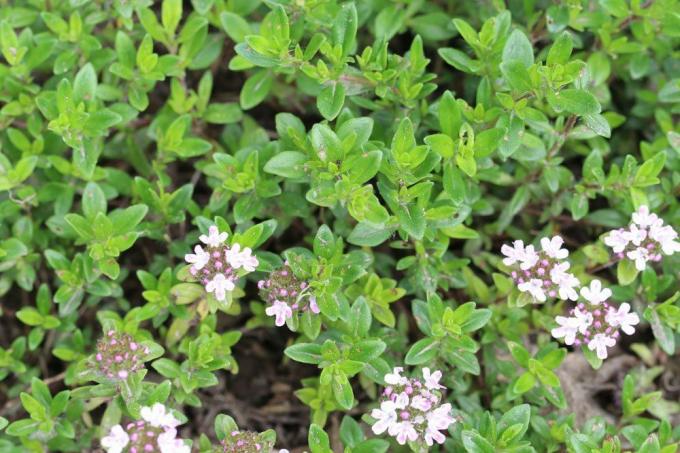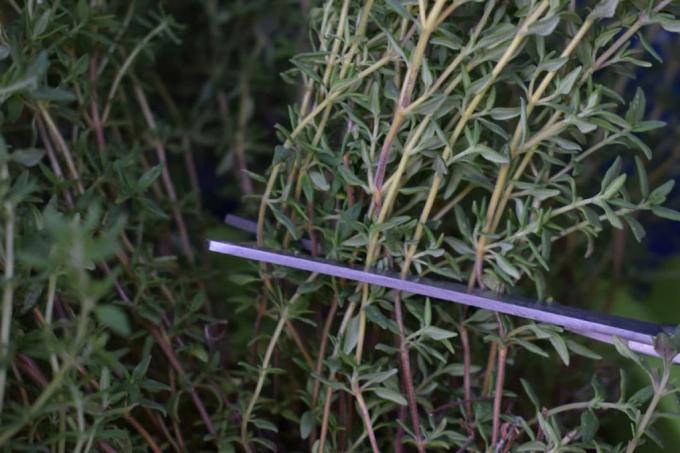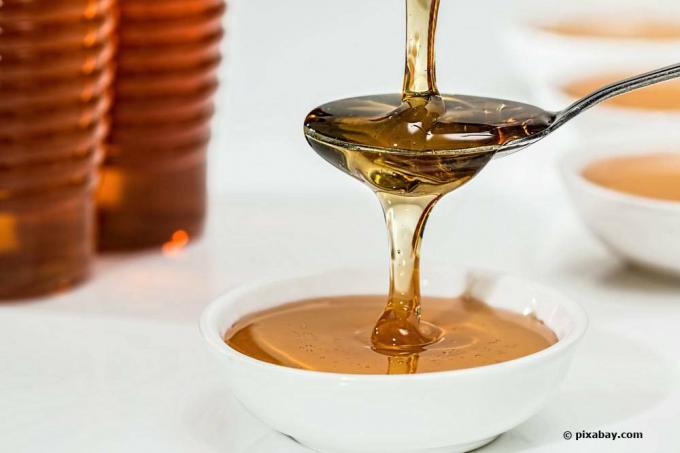
table of contents
- Growth of thyme
- Use in the kitchen
- harvest
- proceed
- Preserve
- dry
- Freeze
- Insertion
- Preserve with other herbs
- frequently asked Questions
Harvesting thyme in your own garden has the advantage that you can use it for seasoning at any time. How to preserve the herb is also in this article.
In a nutshell
- Thyme (thymus) is an aromatic herb for grilled food or tea preparations
- year-round use
- Most tasty in autumn or before flowering
- the flowering time depends on the variety
- Conservation methods: dry, freeze or soak
Growth of thyme
The herb is evergreen. It sprouts new in spring. Flowering then takes place from May to October, depending on the variety.
Regular cutting makes sense to keep the plant vital. If harvesting is frequent, additional pruning is not necessary.

Use in the kitchen
Thyme sprigs are typically used to marinate and flavor grilled food. However, the dried herb also goes very well with fish or potatoes. In contrast to many other herbs, the aroma of the thyme does not disappear if it is cooked for a long time. On the contrary, the taste only develops over a longer period of time.
harvest
The herb can be harvested continuously for the kitchen. To do this, the required leaves or twigs are simply cut off with scissors. The right harvest time plays a bigger role when it comes to creating a store or using it as a medicinal herb.
Choose the right harvest time:
The highest possible content of valuable ingredients is desirable for preservation. The same applies if the healing effects are to be used. As with many other herbs, the essential oil content of thyme is highest shortly before flowering. Further tips for choosing the right time to harvest:
- young shoots have more ingredients than old ones
- Rain and too much sun leach the leaves
- the day should be warm and dry
- the best time of day is late morning or, without midday sun, early afternoon
- the dew should be dry before harvesting
proceed
For use in the kitchen, it is sufficient to harvest individual leaves from the thyme. In order to harvest a larger supply, the shoots are completely cut back. This is due to the fact that the cut surfaces are smaller. The more cut surfaces there are, the faster the ingredients volatilize.

Preserve
There are several ways to preserve sprigs of thyme. The best known are drying and freezing. It is important that you process the herb as soon as possible after harvesting. A longer idle time deteriorates the quality.
dry
Many utensils are not necessary for drying. The thyme branches are cleaned, only washed in an emergency and then tied together in small bundles with thin thread. The bundles are hung in a warm, dry room, out of direct sunlight.
Note: A sock hanger is ideal for hanging up herbs.
A slightly different procedure is used when drying in the oven or dehydrator. Spread the branches flat. Either on the baking sheet or on the grids for the dehydrator. The oven should not be hotter than 50 degrees, the door remains ajar during the drying process.
Modern dehydrators have special setting options for herbs, which makes them very easy to use. Both methods are faster than air drying, which in turn is particularly gentle.
Freeze
This method of preservation keeps the herbs fresh and aromatic for a particularly long time. The sprigs of thyme can be frozen whole or chopped. Pre-freezing on a board or baking sheet makes sense for whole twigs. They are then transferred to freezer bags or cans and labeled with the date and content.
Another variant is to freeze finely chopped thyme sprigs in ice cube trays along with some water. These can later be added to the corresponding dishes without thawing.
Insertion
If you already know exactly what you want to do with the thyme after harvesting, you can preserve it by pickling it. This method of preservation is very diverse. Depending on your preference, different utensils are necessary.

Laying methods:
- oil
- vinegar
- salt
- honey
It is common to all variants that they are easy to use. The thyme branches are cleaned or washed and then dried. When using salt, it is enough to cut the branches a little small. Depending on the size of the glasses or bottles used, the branches that are to be placed in vinegar, oil or honey can remain whole. After placing the twigs in the vessels you have chosen, simply top up the ingredient you have chosen.
When preserving with salt, it is not necessary to dry the branches beforehand. They can be chopped into small jars and layered alternately with salt. The amount of salt must be large enough to cover the herbs well.
Note: Dried herbshowever, you can also use it with salt to make herbal salt.
Preserve with other herbs
Tea blends
If the sprigs of thyme are intended for teas, they can be mixed with other herbs, such as sage, fennel and ribwort are processed. Herbs for teas are always dried. After the herbs have dried thoroughly, they are stored in tightly fitting containers. To do this, they can be shredded a little. The container should be labeled with the tea composition and intended use.
Herbs in cube form
The frost method is suitable for this. For freezing, the sprigs of thyme are chopped together with sage or rosemary and poured into ice cube trays. Combinations with other herbs are also possible. If necessary, the herbs can be used to season the right dish together.

Note: Sage and rosemary are also good to pickle in vinegar or oil with thyme.
frequently asked Questions
Apart from the different content of essential oils and the associated taste differences, the thyme varieties also bloom differently. This means that the time for harvesting can vary from variety to variety.
Many varieties, such as the real thyme (Thymus vulgaris), are and can be harvested all year round. If you choose a thyme that is not winter-proof, it will thrive in a bucket and will overwinter indoors. Shoots can also be cut there for dinner or evening tea.
The essential oils have an expectorant, antibiotic and relieve throat irritation. That is why thyme is often a component of cough lozenges or cough teas.


